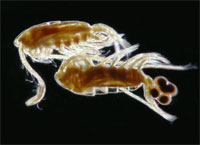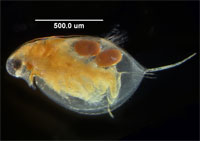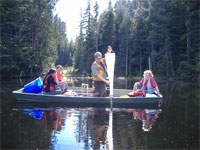Wilder Weather Exerts a Stronger Influence on Biodiversity Than Steadily Changing Conditions
January 15, 2010
Media Contact: Kim McDonald (858) 534-7572
Comment: Jonathan Shurin

Diaptomus nudus, a species of zooplankton found in freshwater lakes
Credit: Danusia Dolecki
An increase in the variability of local conditions could do more to harm biodiversity than slower shifts in climate, a new study has found.
Climate scientists predict more frequent storms, droughts, floods and heat waves as the Earth warms. Although extreme weather would seem to challenge ecosystems, the effect of fluctuating conditions on biodiversity actually could go either way. Species able to tolerate only a narrow range of temperatures, for example, may be eliminated, but instability in the environment can also prevent dominant species from squeezing out competitors.
"Imagine species that have different optimal temperatures for growth. In a fluctuating world, neither can get the upper hand and the two coexist," said Jonathan Shurin, an ecologist at the University of California, San Diego who led the project. Ecologists have observed similar positive effects on populations of organisms as different as herbacious plants, desert rodents, and microscopic animals called zooplankton.

Dark ovals are embryos, the next generation of Daphnia, a type of zooplankton sometimes called a water flea
Credit: Danusia Dolecki
Now a study of zooplankton found in dozens of freshwater lakes over decades of time has revealed both effects. Shurin and colleagues found fewer species in lakes with the most variable water chemistry. But lakes with the greatest temperature variations harbored a greater variety of zooplankton, they report in the journal Ecology Letters January 21.
Their study considered data from nine separate long-term ecological studies that included a total of 53 lakes in North America and Europe. In addition to sampling zooplankton, scientists had also taken physical measurements repeatedly each season for periods ranging from 3 to 44 years.
From these data, they calculated the variability of 10 physical properties, including pH and the levels of nutrients such as organic carbon, phosphorous and nitrogen. Temperatures and the amount of oxygen dissolved in the water at both the surface and bottom of each lake were also included. The authors also teased apart variation based on the pace of change with year-to-year changes considered separately from changes that occurred from season-to-season or on more rapid timescales.
Zooplankton populations respond quickly to changes because they reproduces so fast. "In a summer, you're sampling dozens of generations," Shurin said. "For mammals or annual plants, you would have to watch for hundreds or thousands of years to see the same population turnover."

Students of Jonathan Shurin sample plankton from a Canadian lake.
At every time scale the pattern held: Ecologists found fewer species of zooplankton in lakes with fluctuating water chemistry and greater numbers of species in those with varying temperatures. The authors noted that the temperature variations they observed remained within normal ranges for these lakes. But some chemical measures, particularly pH and levels of phosphorous, strayed beyond normal limits due to pollution and acid rain.
Environmental variability through time could either promote or reduce biodiversity depending on the pace and range of fluctuations, the authors suggested.
"It may depend on the predictability of the environment. If you have a lot of violent changes through time, species may not be able to program their life cycles to be active when conditions are right. They need the ability to read the cues, to hatch out at the right time," Shurin said. "If the environment is very unpredictable, that may be bad for diversity, because many species just won't be able to match their lifecycles to that."
Shurin's 10 co-authors include scientists from environmental agencies in Canada, and universities and research institutes in Canada, Germany, Switzerland and the United States. The Natural Sciences and Engineering Research Council of Canada supported Shurin's work on this study.
